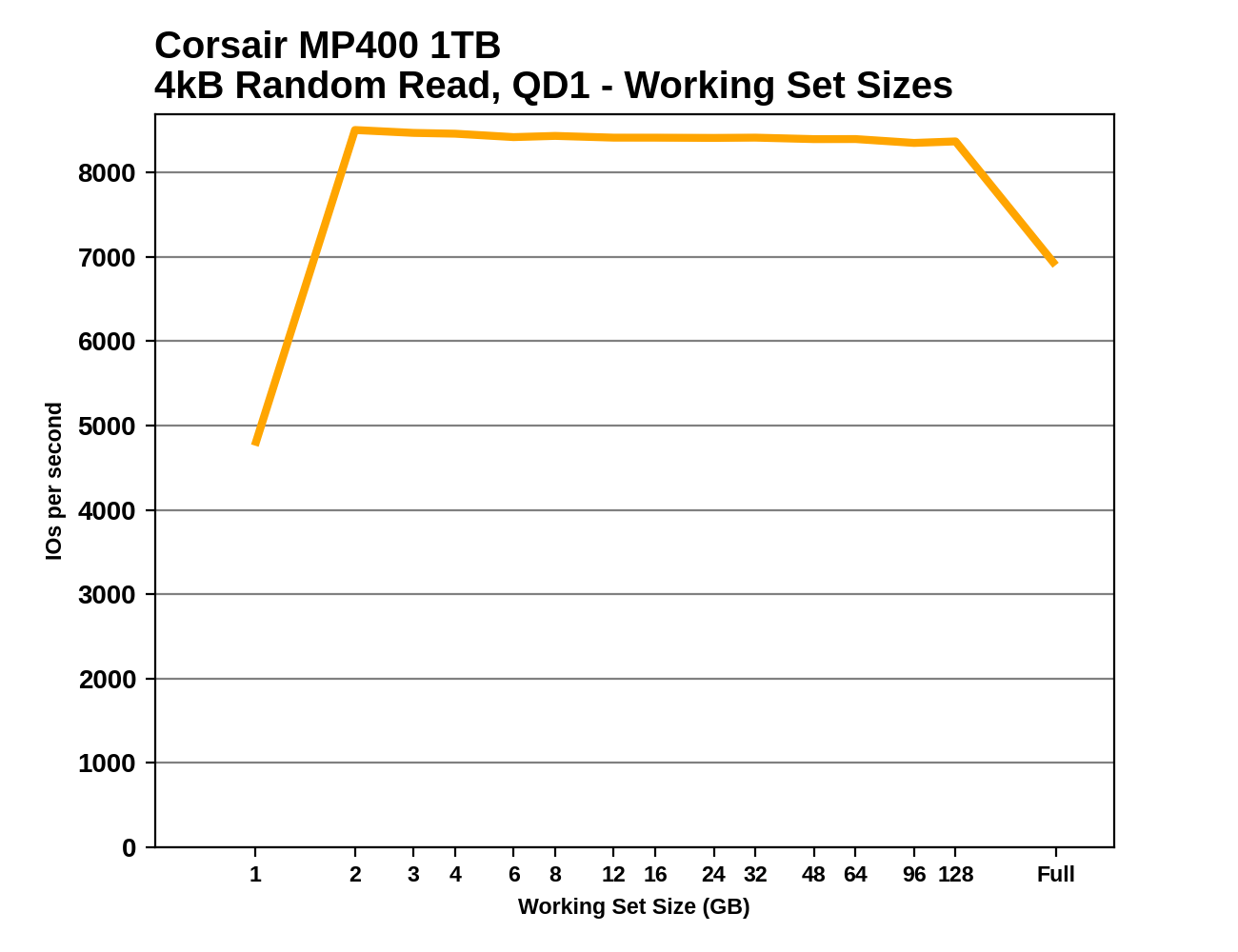The Corsair MP400 1TB QLC NVMe SSD: A Quick Review
by Billy Tallis on December 11, 2020 2:00 PM ESTWhole-Drive Fill
This test starts with a freshly-erased drive and fills it with 128kB sequential writes at queue depth 32, recording the write speed for each 1GB segment. This test is not representative of any ordinary client/consumer usage pattern, but it does allow us to observe transitions in the drive's behavior as it fills up. This can allow us to estimate the size of any SLC write cache, and get a sense for how much performance remains on the rare occasions where real-world usage keeps writing data after filling the cache.
 |
|||||||||
The Corsair MP400 opts for the largest possible SLC cache size, allowing for a quarter of the drive's advertised capacity to be written to the cache before performance plummets. This is the same strategy used by the Sabrent Rocket Q and probably all other QLC drives using Phison controllers. The Intel and Crucial QLC drives based on Silicon Motion's SM2263 controller have somewhat smaller variable-sized SLC caches, while the Samsung QLC SATA drives use the same small SLC cache sizes as their TLC counterparts.
 |
|||||||||
| Average Throughput for last 16 GB | Overall Average Throughput | ||||||||
Overall drive fill performance for the Corsair MP400 is marginally faster than for the other 1TB QLC drives we've tested, but the DRAMless TLC drives and the larger Sabrent Rocket Q are considerably faster. However, all of the budget NVMe drives are clearly much slower for sustained writes than the mainstream and high-end TLC drives.
Working Set Size
 |
|||||||||
The random read latency from the Corsair MP400 is quite similar to what we saw from the 8TB Sabrent Rocket Q, especially for medium to large working sets. The 1TB MP400 doesn't exhibit the same unsteady performance for small working sets as the 8TB Rocket Q, but instead only shows poor performance for the absolute smallest working set size tested.
The performance drop-off when performing random reads across the entire drive is expected and normal, because the Crucial P1 is the only QLC drive in this bunch to include the full 1GB per 1TB of DRAM. Most low-end DRAMless TLC drives will show an even earlier drop in performance, and many of the more mainstream TLC drives that have switched to a lower DRAM ratio will also show the same drop that the Rocket Q and MP400 show.










75 Comments
View All Comments
madmilk - Saturday, December 12, 2020 - link
The 840 Evo is probably the worst drive Samsung has ever shipped. The first gen 2D TLC memory in the drives caused a ton of performance issues thanks to losing the charge in the flash cells leaking out rather quickly. Samsung had to push out a bunch of firmware bandaids for the issue and switched to 3D TLC for the 850 Evo. Even then, I don't think many people managed to wear them out.Beaver M. - Saturday, December 12, 2020 - link
My 840 is stored at low temperatures 5 months a year without any power source. Still works like new.Spunjji - Monday, December 14, 2020 - link
The 840 (not Pro, not Evo) would definitely take that title - it's like the Evo but without any caching or a firmware fix for the read degradation. Even with that said, I still have a couple of the absolute worst-case drives - the 840 120GB - hanging around in service as boot drives for seldom-used systems, which is a role they perform relatively well even in spite of their unique form of bit-rot. Maybe it's because Windows 10 basically rewrites the whole damn OS every 6 months? 😂Oxford Guy - Monday, December 14, 2020 - link
"which is a role they perform relatively well even in"Not according to HardOCP which found they had worse steady state performance than laptop hard drives.
Gigaplex - Wednesday, December 16, 2020 - link
It was still better than the 840 non-EvoBeaver M. - Saturday, December 12, 2020 - link
If your case is worth anything, then the logical conclusion for SSD manufacturers should be to increase warranty and TBW massively.Huh. I wonder why they dont.
joesiv - Monday, December 14, 2020 - link
Care to share your SMART data for one of the drives? I'm curious.lmcd - Friday, December 11, 2020 - link
While this drive is an interesting reference point, that extra $20 (or less) for a SK Hynix P31 is easily worth it.Zzzoom - Friday, December 11, 2020 - link
DWPD calculations on page 1 are wrong.zepi - Saturday, December 12, 2020 - link
This latest gen QLC with 8 channels looks too good so that it would disappear...In sizes from 2TB and up, it iss probably a good choice for anyone looking for a cheap drive. And thanks to SLC caching 4k random writes are crazy fast.
One can always increase SLC cache amount by leaving 50-100G unpartitioned to make sure there is good amount of SOC cache even when filling the drive with one more Steam download.